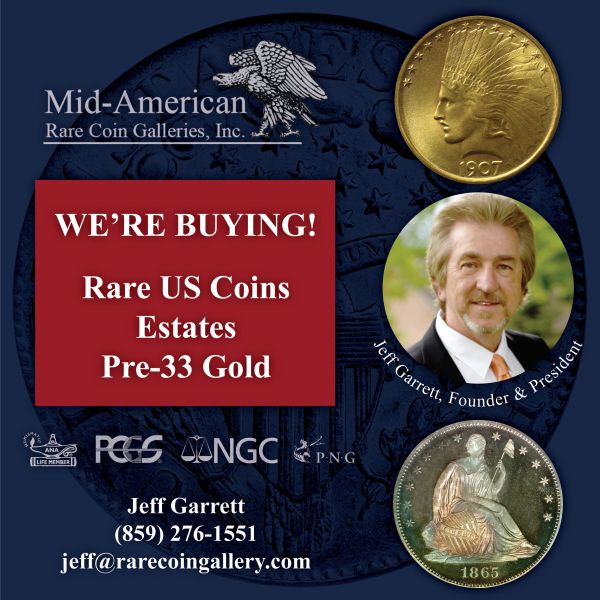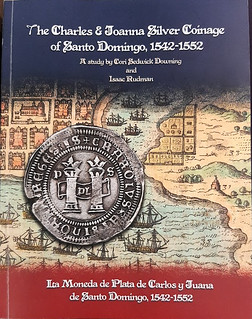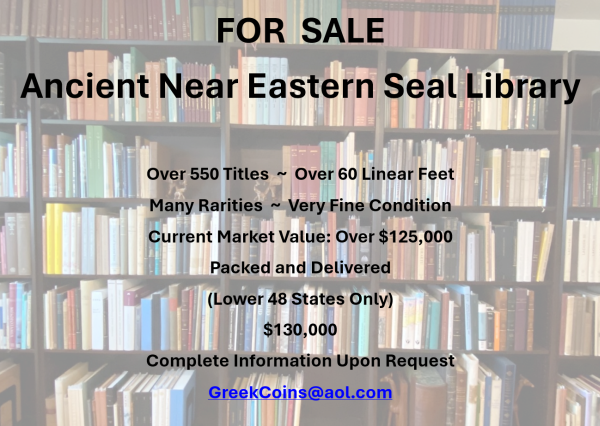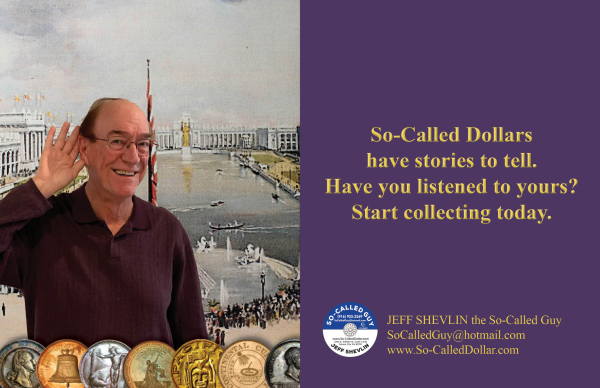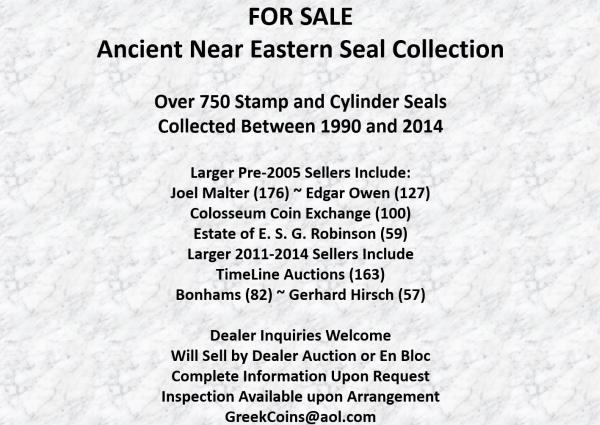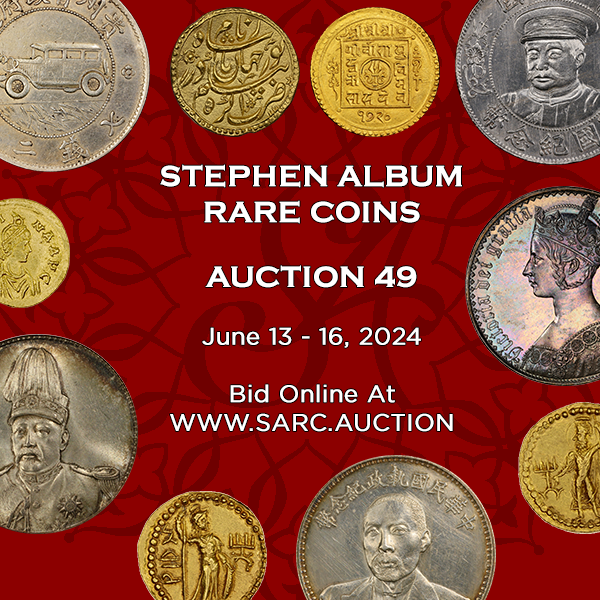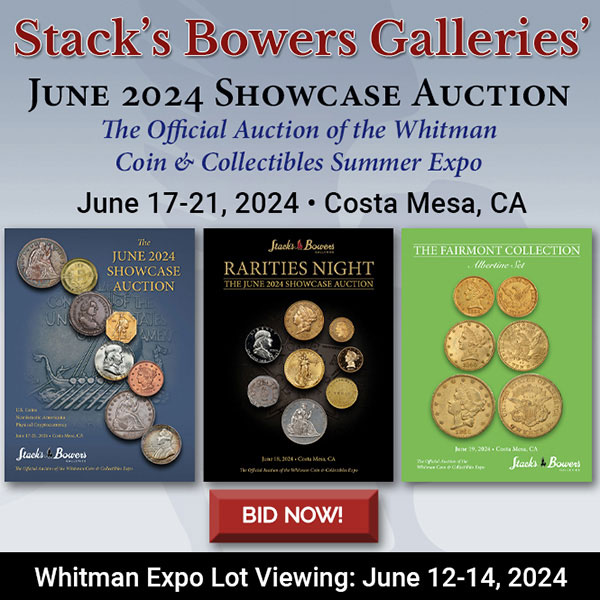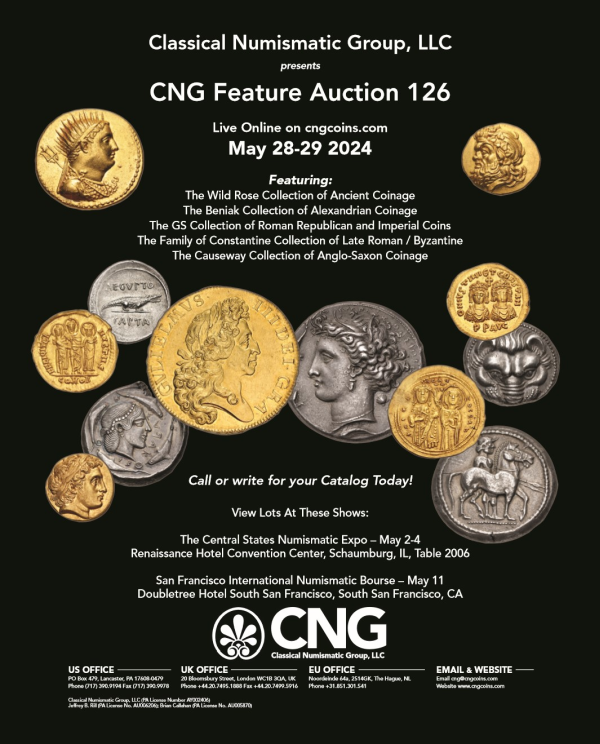
Visit our NBS Sponsors



About UsThe Numismatic Bibliomania Society is a non-profit association devoted to the study and enjoyment of numismatic literature. For more information please see our web site at coinbooks.org SubscriptionsThose wishing to become new E-Sylum subscribers (or wishing to Unsubscribe) can go to the following web page link MembershipThere is a membership application available on the web site Membership Application To join, print the application and return it with your check to the address printed on the application. Print/Digital membership is $40 to addresses in the U.S., and $60 elsewhere. A digital-only membership is available for $25. For those without web access, write to: Jeff Dickerson, Treasurer AsylumFor Asylum mailing address changes and other membership questions, contact Jeff at this email address: treasurer@coinbooks.org SubmissionsTo submit items for publication in The E-Sylum, write to the Editor at this address: whomren@gmail.com BUY THE BOOK BEFORE THE COIN |
- WAYNE'S WORDS: THE E-SYLUM MAY 26, 2024
- ASYLUM SUMMER 2024 ISSUE PUBLISHED
- KOLBE & FANNING JUNE 2024 SALE ANNOUNCED
- COIN BOARD HOARD SALE
- 2024 IAPN BOOK PRIZES ANNOUNCED
- MAY 2024 NNP SYMPOSIUM VIDEOS AVAILABLE
- NEWMAN GRANTS 2024 AWARD ANNOUNCEMENT
- VIDEO: HISTORY OF WELLS FARGO
- 2024 PNG AWARDS NOMINATIONS NOW OPEN
- MORE ON EARLIER BRUUN COLLECTION SALES
- NOTES FROM E-SYLUM READERS: MAY 26, 2024
- ROMA NUMISMATICS CEASES OPERATIONS
- OWEN LINZMAYER JOINS CDN PUBLISHING
- VOCABULARY TERM: PLASTER CASTING
- ALFRED EDWARDS EMERSON (1859-1943)
- ATLAS NUMISMATICS SELECTIONS: MAY 26, 2024
- RARE INDIA BANKNOTES FROM WWI SHIPWRECK
- THE HOWARD GIBBS ARCHIVES
- STACK’S BOWERS BRUUN COLLECTION, PART I
- WAYNE'S NUMISMATIC DIARY: MAY 26, 2024
- DR. STAHL VISITS JERSEY COIN HOARD
- USING AI TO ANALYZE COIN HOARDS
- WWII POW DOG DICKIN MEDAL LETTER
- CROCODILE-PUNCHING WOMAN'S MEDAL
- COIN DONATIONS OVERWHELM AUTISTIC BOY
- $1 MILLION LEFT AT AIRPORT SECURITY
Content presented in The E-Sylum is not necessarily researched or independently fact-checked, and views expressed do not necessarily represent those of the Numismatic Bibliomania Society.
WAYNE'S WORDS: THE E-SYLUM MAY 26, 2024
 New subscribers this week include:
Evan Saltis,
Jim Turner, and
J. Patrick Wooten.
Welcome aboard! We now have 7,262 subscribers.
New subscribers this week include:
Evan Saltis,
Jim Turner, and
J. Patrick Wooten.
Welcome aboard! We now have 7,262 subscribers.
Thank you for reading The E-Sylum. If you enjoy it, please send me the email addresses of friends you think may enjoy it as well and I'll send them a subscription. Contact me at whomren@gmail.com anytime regarding your subscription, or questions, comments or suggestions about our content.
This week we open with sales of numismatic literature and coin boards, the IAPN Book Prizes, updates from the Newman Numismatic Portal, notes from readers, and more.
Other topics this week include Wells Fargo, the Bruun collection, Roma Numismatics, plaster casting, fixed price and auction selections, my numismatic diary, and the Jersey coin hoard.
To learn more about The Missing Book, Howard Gibbs, the M.K. McMullin collection, the Robert Friedberg Award, my Personal Time Tunnel, a Buick encased silver dollar, Dr. Alfred Emerson, numismatic tattoos, spatulation, and the crocodile-punching woman, read on. Have a great week, everyone!
Wayne Homren
Editor, The E-Sylum
ASYLUM SUMMER 2024 ISSUE PUBLISHED
The Summer 2024 issue of the print journal The Asylum is on the way from our sponsor, the Numismatic Bibliomania Society. Another great issue, with lots of interesting reading and research. Thanks and congratulations to all the contributors. -Editor
Welcome to The Asylum's Summer 2024 edition.
- A Little Dry Reading for the Antiquaries (Part Four) By Joel J. Orosz
- The Missing Book By Charles Sullivan
- Good Numismatic Reads By Jeff Dickerson
- A Bibliographic Study of United States Commemorative Coinage Literature By Mike Costanzo
- Forgery or Reproduction—An Analysis By Shanna Schmidt
- A Piece of Very Important, Coin-Related, (non) Numismatic Literature By Greg Bennick
KOLBE & FANNING JUNE 2024 SALE ANNOUNCED
Kolbe & Fanning have announced their next numismatic literature sale, featuring books on ancient, world and U.S. numismatics, including another consignment from yours truly. See an article elsewhere in this issue for more information on one of the lots. -Editor
June 15 Sale of Numismatic Books
 Kolbe & Fanning Numismatic Booksellers are pleased to announce that we will be holding our next auction sale on Saturday, June 15, 2023. The sale includes rare and out-of-print works on ancient, world and U.S. numismatics from the libraries of Wayne Homren and other consignors. With over 500 lots, there is something for everybody.
Kolbe & Fanning Numismatic Booksellers are pleased to announce that we will be holding our next auction sale on Saturday, June 15, 2023. The sale includes rare and out-of-print works on ancient, world and U.S. numismatics from the libraries of Wayne Homren and other consignors. With over 500 lots, there is something for everybody.
Some highlights of this first sale include:
COIN BOARD HOARD SALE
Justin Hinh (aka Dansco Dude) submitted this report on a large collection of coin boards now coming to market. This is a great opportunity to complete or start a new collection. -Editor
 I wanted to give a heads-up to The E-Sylum readership about the 'Coin Board Hoard'. In late April, I flew to Green Bay, Wisconsin to help a collector sort through and prepare for the sale of the world's largest collection of coin boards. Over 1700+ vintage coin boards, folders, and albums are coming into the market.
I wanted to give a heads-up to The E-Sylum readership about the 'Coin Board Hoard'. In late April, I flew to Green Bay, Wisconsin to help a collector sort through and prepare for the sale of the world's largest collection of coin boards. Over 1700+ vintage coin boards, folders, and albums are coming into the market.
Coin-collecting boards gained popularity in the 1930s and 1940s as a way to make the hobby more accessible to the average American family during the Great Depression era. Because coin boards were much cheaper to produce than coin cabinets, they played a significant role in popularizing coin collecting. It moved coin collecting from "The Hobby of Kings" to "The Hobby of Everyone". The boards themselves have become highly sought-after collectibles.
THE BOOK BAZARRE
2024 IAPN BOOK PRIZES ANNOUNCED
The International Association of Professional Numismatists (IAPN) has announced the winners of their 2024 book prizes. Thanks, and congratulations to all the authors and publishers. -Editor
Peter Preston-Morley writes:
"I just wanted to advise your readers of the result of this year’s Book Prize, which was decided by vote of the membership of the IAPN at its 72nd General Assembly in San Francisco on Sunday, 19 May.
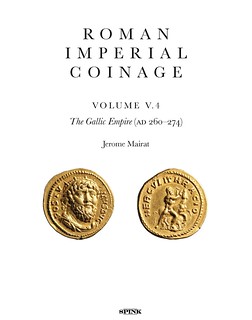 The winner is Jerome Mairat, curator of Roman Coins at the Ashmolean Museum, Oxford, England, for his Roman Imperial Coinage, vol. V.4: The Gallic Empire (AD 260-274), published by Spink in London. Second prize went to Cori Sedwick Downing, a senior numismatist at the house of Daniel Frank Sedwick in Winter Park, Florida, and Isaac Rudman, a collector from the Dominican Republic, for their The Charles & Joanna Silver Coinage of Santo Domingo, 1542-1552, published by Isaac Rudman in Santo Domingo. Third prize went to Glenn Murray, the Spanish-domiciled 72-year old Los Angeles-born numismatist, for his Boato y Tecnología: Cincuentines, centenes y escudos de a echo, published by the Asociación Amigos de la Casa de la Moneda de Segovia, in Segovia, Spain.
The winner is Jerome Mairat, curator of Roman Coins at the Ashmolean Museum, Oxford, England, for his Roman Imperial Coinage, vol. V.4: The Gallic Empire (AD 260-274), published by Spink in London. Second prize went to Cori Sedwick Downing, a senior numismatist at the house of Daniel Frank Sedwick in Winter Park, Florida, and Isaac Rudman, a collector from the Dominican Republic, for their The Charles & Joanna Silver Coinage of Santo Domingo, 1542-1552, published by Isaac Rudman in Santo Domingo. Third prize went to Glenn Murray, the Spanish-domiciled 72-year old Los Angeles-born numismatist, for his Boato y Tecnología: Cincuentines, centenes y escudos de a echo, published by the Asociación Amigos de la Casa de la Moneda de Segovia, in Segovia, Spain.
The value of the Prize is 1,000 CHF. The winner also receives a diploma and an IAPN medal, and it is hoped that these can be presented to him at a future IAPN function."
MAY 2024 NNP SYMPOSIUM VIDEOS AVAILABLE
The latest additions to the Newman Numismatic Portal are videos recorded at the May 2024 NNP Symposium. Project Coordinator Len Augsburger provided the following report. -Editor
Newman Portal Symposium Video Available
Presentations from the Newman Portal Symposium held May 2-4, 2024 are now available online. Our feature video for this event, produced by Numismatic Marketing, is "Benjamin Franklin and Numismatics." This piece explores Franklin's connections with early American coins, medals, and paper money. Following the video is an appearance by Franklin himself, in the person of Patrick McBride. Additional presentations, by Farley Grubb and Khachatur Manykyan, further explore Franklin's numismatic contributions during the formative years of the United States. A total of eighteen sessions from this event, held in conjunction with the Central States Numismatic Society 2024 convention, are now posted at the link noted.
NEWMAN GRANTS 2024 AWARD ANNOUNCEMENT
Len Augsburger provided this announcement of the 2024 Newman Grants on May 25th, the birthday of the late Eric P. Newman. Some great projects outlined here. -Editor
Eric P. Newman Numismatic Education Society Announces Newman Grants
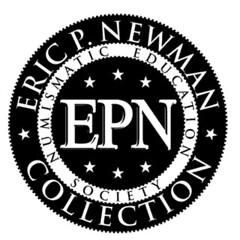 The Eric P. Newman Numismatic Education Society (EPNNES) today announces its fifth set of Newman Grants, created to financially assist numismatic authors and organizations pursuing original research in American and world numismatics. Newman Grants are awarded annually on the late Eric P. Newman’s birthday and assist with direct costs of numismatic research such as travel, photography, and graphic arts services.
The Eric P. Newman Numismatic Education Society (EPNNES) today announces its fifth set of Newman Grants, created to financially assist numismatic authors and organizations pursuing original research in American and world numismatics. Newman Grants are awarded annually on the late Eric P. Newman’s birthday and assist with direct costs of numismatic research such as travel, photography, and graphic arts services.
Five awards are being made this year, touching on varied numismatic topics. The 2024 Newman Grant awardees are as follows:
VIDEO: HISTORY OF WELLS FARGO
The David Lisot Video Library on the Newman Numismatic Portal can be found at:
https://nnp.wustl.edu/library/multimediadetail/522852
We highlight one of his videos each week in The E-Sylum. Here's one from 2005 with Robert J. Chandler speaking about the History of Wells Fargo -Editor
2024 PNG AWARDS NOMINATIONS NOW OPEN
E-Sylum readers and contributors are stalwarts of the numismatic community. Consider nominating them or their works for the 2024 PNG Awards. -Editor
 The Professional Numismatists Guild is now accepting nominations for its 2024 awards, according to PNG Executive Director John Feigenbaum.
The Professional Numismatists Guild is now accepting nominations for its 2024 awards, according to PNG Executive Director John Feigenbaum.
“The PNG publicly recognizes outstanding achievements in the hobby and the profession by honoring deserving recipients with prestigious awards. We cordially welcome and strongly encourage nominations from all collectors and dealers,” said Feigenbaum.
“The award winners will be announced on August 6 during a PNG cocktail reception at the American Numismatic Association Chicago Worlds’ Fair of Money in Rosemont, Illinois,” explained PNG President and Awards Committee Chairman James Sego.
MORE ON EARLIER BRUUN COLLECTION SALES
David Tripp submitted these notes on the disposition of the first groups of coins sold from the Bruun collection. Thank you! See the article elsewhere in this issue for details on Part I of the Stack's Bowers Bruun sales. -Editor
As ever, the E-Sylum begins my week with stimulation. My thanks.
First, on my great old friend and colleague David Redden. Personally and professionally, simply irreplaceable.
Your Bruun collection query tweaked something in me, since when I working on the Brand sales in the 1980s there were a few Scandinavian coins (extremely good ones) and Bruun was the source of most.
NOTES FROM E-SYLUM READERS: MAY 26, 2024
Happy For The Help
Gerry Tebben writes:
 "Congrats on getting an assist from Garrett Ziss. I’ve been amazed at what you’ve been able to do by yourself over the years."
"Congrats on getting an assist from Garrett Ziss. I’ve been amazed at what you’ve been able to do by yourself over the years."
Julia Casey writes:
"Not that you weren't juggling it all splendidly, Ye Maestro Nummorum, but I'm glad (for you) that you will be getting some assistance with the burgeoning Goliath that is our beloved E-Sylum."
Thanks - I'm very glad to have Garrett aboard; he assisted with several articles this week. -Editor
Adrián González-Salinas writes:
"I'm glad that you can have the support of Garrett Ziss in the weekly edition of The E-Sylum. Welcome aboard Garrett!
"For many years, I have wondered how Wayne K. Homren reads, proofreads and edits the articles submitted by readers of The E-Sylum every week and then distributes this publication in a timely manner with better-than-atomic-clock punctuality from Fort Collins, Colorado. The conclusion I have come to is that Wayne has a Personal Time Tunnel such that when he starts editing The E-Sylum he transports himself into his Tunnel so that time stands still and when he finishes editing and distributing it only a few nanoseconds have passed on Earth. In short, I can't imagine how Wayne has time to do all these activities as Editor of The E-Sylum!!!!
"As usual, many congratulations to Wayne Homren."
Drat, my secret's out. Thanks for the image, but it's making me dizzy. Wait here while I go buy some more Nvidia stock two years ago. -Editor
To read the earlier E-Sylum article, see:
GARRETT ZISS TO ASSIST E-SYLUM EDITOR
(https://www.coinbooks.org/v27/esylum_v27n20a02.html)
Other topics this week include Why Do So Many Latin American, Spanish & Filipino Coins Have Holes?, Uncashed U.S. Treasury Checks, and a Buick Encased Silver Dollar. -Editor
ROMA NUMISMATICS CEASES OPERATIONS
In the continued fallout over two rare ancient coins sold at auction in 2020 with falsified provenances, Roma Numismatics Limited, has ceased operations. Owner Richard Beale had been arrested and later admitted buying false ownership history documents for both coins. -Editor
OWEN LINZMAYER JOINS CDN PUBLISHING
Banknote Book editor Owen Linzmayer has joined CDN Publishing as Product Manager to oversee the massive catalog of world paper money. -Editor
On the 13th anniversary of publishing The Banknote Book (BNB), CDN Publishing is pleased to announce that its editor, Owen W. Linzmayer, has recently been hired as the Product Manager to oversee the most comprehensive catalog of world paper money in existence. Linzmayer has extensive experience writing for national computer magazines, has authored many technology books including the best-selling Apple Confidential, and served as the editor of the International Bank Note Society Journal.
In 2011, Linzmayer began publishing The Banknote Book with an initial release of 10 country-specific chapters. From these humble beginnings, the catalog has swelled to over 320 chapters (and growing), with more than 9,600 pages covering almost 100,000 types and varieties, with a steady stream of new material and revisions released every week. Available in digital form via subscription on greysheet.com, The Banknote Book is now widely regarded as the new standard reference for the hobby, and a must-have for all serious collectors and dealers of paper money.
VOCABULARY TERM: PLASTER CASTING
Here's another entry from Dick Johnson's Encyclopedia of Coin and Medal Terminology. -Editor
Plaster Casting. Preparing a three-dimensional cast for a more permanent, transferable, reproducible form in plaster of Paris. Plaster casting requires a craftsman skilled in preparing the model, mixing the plaster with water, pouring the plaster and removing air bubbles. Plaster casting is easy to learn and proficiency comes early, but there are many variables – kinds of plaster, time, temperature, release agents – in addition to the caster's skill. While some of these variables are the operator's choice, as hard or soft plaster, the use dictates others. For example, a super fine hard plaster is preferred in the coin and medal field but the caster may prefer one brand over another. Hydrocal and Densite are brands of commercial plaster used in the modeling of coins and medals.
ALFRED EDWARDS EMERSON (1859-1943)
E-Sylum Feature Writer and American Numismatic Biographies author Pete Smith submitted this article on the founder of the Cornell University coin collection, Dr. Alfred Emerson. Thanks! -Editor
I’ve gotten a little behind with my reading. This week I was reading The Chicago Tribune from March 13, 1913. An article mentioned an old coin found in an Indian mound in Hancock County, Illinois. It had been taken to the Chicago Art Institute for examination by Alfred Emerson.
“Dr. Emerson, who is considered one of the nation’s greatest numismatists, said he had never seen a coin like it and could only estimate that it had been made in Rome or Greece during the period between 250 B.C. and 250 A.D.”
Well, if he was one of the nation’s greatest numismatists, I thought I should learn more about him.
ATLAS NUMISMATICS SELECTIONS: MAY 26, 2024
Atlas Numismatics has updated their website with 141 new coins, medals, and tokens at fixed prices. Selections include the following items. -Editor
1078302 | AUSTRALIA. Victoria. (Queen, 1837-1901). 1855-(sy) AV Sovereign. PCGS MS62. Sydney. Edge: Milled. Fillet head. KM 2.
Superb lustrous surfaces; extremely rare in this quality.
Ex. Baldwin's New York Sale IX (January 2005) Lot 232 ($42,500 hammer).
$46,500
RARE INDIA BANKNOTES FROM WWI SHIPWRECK
We often learn about coins recovered from shipwrecks, but banknotes? Not so much. It's rare that these survive. Noonan's will be offering two such banknote survivors in their upcoming sale. Here's the press release. -Editor
Two 10-rupee banknotes that were recovered from the wreck of the SS Shirala, which was sunk by a German U-boat on 2 July 1918 will be offered at Noonans Mayfair on Wednesday, May 29, 2024, in a sale of World Banknotes. They are each estimated to fetch £2,000-2,600.
As Thomasina Smith, Worldwide Head of Numismatics at Noonans, explained: “Whole blocks of these notes, along with lots of provisions ranging from marmalade to ammunition, were on their way to Bombay from London when the boat was sunk by a German U-Boat. Many notes floated to shore, including unsigned 5 and 10 Rupees, and signed 1 Rupees (one of which also features in this auction). Most were recovered and subsequently destroyed by the authorities and new ones were printed to replace them, however a very few examples remained in private hands.”
THE HOWARD GIBBS ARCHIVES
One of my most memorable acquisitions was the Howard Gibbs Archives, now offered as lot 183 in the upcoming Kolbe & Fanning sale. Here's David Fanning's beefy lot description. -Editor
[Gibbs, Howard D.]. ARCHIVAL NUMISMATIC MATERIAL RELATING TO HOWARD GIBBS AND HIS COLLECTIONS. Arranged in seven groups, as follows:
1. Gibbs’s heavily annotated copy of the 1954 Sotheby & Co. sale of the King Farouk collection (The Palace Collections of Egypt: Catalogue of the Important and Valuable Collection of Coins and Medals, the Property of the Republic of Egypt). Annotations mostly pertain to Gibbs’s own collecting interests and especially to his bids in the sale and interest in items purchased by dealers at the sale. A number of lots have buyers’ names recorded, though no effort was given to do this systematically. Price list present. Worn, with taped spine. Also present is the third edition of Gibbs’s Odd and Curious Money of the World: A Complete Register, published in 1956 by Hans M.F. Schulman and signed by Gibbs.
2. Correspondence (original and carbon-copy) between Gibbs and Hans M.F. Schulman, most of it dealing with the gradual sale at auction of Gibbs’s collection. Dozens of additional letters are also present, arranged in folders by date from 1938 to 1973. Correspondents include J. van der Hoop, Frank Katen, Joseph B. Stack, Paul Mellon, Carl Cramer, Stuart Mosher, Paul Reinhold, Louis E. Eliasberg, Sr., Arthur S. Dewing, Louis C. West, Lou Werner, Ramon Torres Fuentes, Donald Milligen, Albert Baldwin, Kunizo Minagi, Alan Craig, Vernon Brown, Don Sherer, H.A. Fehlmann, Michael Scott, William T. Anton, Sr., William T. Anton, Jr., Jack Ogilvie, Luis F. Ardois, Pablo I. de Jesus, Jack R. Koch, Capt. David C. Amey, Ed Rochette, and many others. Most letters to Gibbs are originals, though occasional material is present in photocopy; most letters from Gibbs are carbon-copies. The correspondence extends past Gibbs’s death and includes letters concerning his estate. Also present is a typescript of The Story of the Gibbs Collection of Odd and Curious Money and photocopies of articles about his collection.
STACK’S BOWERS BRUUN COLLECTION, PART I
This press release outlines Part I of the Stack’s Bowers sale of the L. E. Bruun Collection. Great coins. -Editor
Stack’s Bowers Galleries proudly announces auction details for Part I of the L. E. Bruun Collection, the world’s finest private collection of Scandinavian coinage, which has been insured for 500 million Danish kroner (about US$72.5 million). This inaugural auction will be held September 14, 2024 at Odd Fellow Palace in Copenhagen, Denmark.
Nearly 300 gold and silver rarities from Denmark, Norway, and Sweden, will be featured in this debut offering from Bruun’s 20,000-piece collection. The coins to be offered stretch from the late 15 th century to within a few years of Bruun’s death in the early 20 th century, and are valued at over US$10 million.
WAYNE'S NUMISMATIC DIARY: MAY 26, 2024
On Tuesday May 21, 2024 I left work and made a detour on my way home. My destination was Not Your Average Joe's restaurant in Reston for the monthly dinner meeting of my Northern Virginia numismatic social group Nummis Nova. I was early and found Dave Schenkman and Eric Schena seated at a corner of the spacious bar. I took a seat next to them just as we were joined by Wayne Herndon and his guest, dealer Evan Saltis from Auburn, Maine.
DR. STAHL VISITS JERSEY COIN HOARD
A BBC News article highlights Alan Stahl's recent visit to the massive coin hoard found in Jersey. -Editor
Dr. Alan Stahl travelled from Princeton University in New Jersey to learn more about the ancient collection.
The hoard was found in 2012 in a field in the parish of Grouville by Reg Mead and Richard Miles.
Dr. Stahl said there were still a lot of questions about the coins which needed to be answered.
"We don't usually, on the continent where I work, get 60,000 coins in a hoard."
USING AI TO ANALYZE COIN HOARDS
In addition to studying the history of the time a hoard was placed, numismatists can learn quite a lot from the coins themselves, and artificial intelligence is helping ease the chore. This new paper published on PCI Archaeology describes how AI can assist with sifting through a large trove of hoard data for new insights. Thanks to Ted Banning for passing this along. -Editor
In the project "Classifications and Representations for Networks: From types and characteristics to linked open data for Celtic coinages" (ClaReNet) we had access to image data for one of the largest Celtic coin hoards ever found: Le Câtillon II with nearly 70,000 coins. Our aim was not to develop new processes, but rather to demonstrate how existing tools can be used to support the numismatic task of processing and analysing large complexes of coins, thus validating the enormous potential of IT-based methods. Our pipeline thus included the following steps:
WWII POW DOG DICKIN MEDAL LETTER
Numismatic bibliophiles and researchers love to discover written and printed ephemera documenting the history of coins, medals, tokens and paper money. This article describes the discovery of the letter of recommendation for a very special Dickin-medal winning dog. -Editor
The official announcement awarding the 'animal Victoria Cross' to the only dog ever to be officially registered as a British prisoner of war has been discovered at The National Archives (TNA).
Judy, a liver-and-white pointer, was the mascot of the HMS Grasshopper, a Royal Navy gunboat on the Yangtze River during the Second World War.
The Grasshopper was sunk by the Japanese in February 1942 during the evacuation of Singapore. The crew abandoned ship and rowed to an uninhabited island, realising afterwards that Judy was not with them. She was discovered trapped below decks under fallen lockers by a crewman sent back to the wreckage of Grasshopper to salvage food.
CROCODILE-PUNCHING WOMAN'S MEDAL
While the thought of a crocodile-punching woman is amusing, the real-life situation described here is decidedly anything but. The young woman has received a well-deserved medal for her heroic death-defying actions to save her twin sister. -Editor
A woman who punched a crocodile in the snout to save her sister is among the recipients of bravery awards included on the king’s first civilian gallantry list.
Georgia Laurie attacked the reptile when it went for her twin, Melissa, dragging her underwater while they were swimming in a lagoon near Puerto Escondido, Mexico, in June 2021. Both sisters were seriously hurt but survived.
Georgia, 31, from Sandhurst in Berkshire, will receive the Gallantry Medal, which acknowledges exemplary acts of bravery. She described the award as “a silver lining” to their traumatic ordeal.
“It’s been a good thing for not just me but for the whole family. I feel like I have to share it with my sister because let’s face it I don’t think I would have been nominated for it if she didn’t survive,” she said. “What’s made this story so incredible is Melissa’s unwavering bravery throughout it all because she was so strong during it and I don’t think I would be here without her. She really gave me the strength to keep fighting.”
COIN DONATIONS OVERWHELM AUTISTIC BOY
All of us whose attention turned to coins at a young age can see themselves in this young man, whose mother gathered donations to jumpstart his collection. -Editor
A boy's beloved coin collection has expanded rapidly with an influx of donations from generous neighbours.
Tommy Dawson, who is autistic and has ADHD, developed what his mother called a "fixation with coins" after taking up magnet fishing.
Describing the nine-year-old Stockton boy as a "jackdaw" who loves rifling through his coins, Helen Dawson said: "He likes the shiny ones and those from the year he was born best."
$1 MILLION LEFT AT AIRPORT SECURITY
So how many people in the U.S. still have change jingling in their pockets? This study answers the question by looking at the coins left behind by people going through airport security checks. -Editor
 Should the U.S. get rid of pennies, nickels and dimes? The debate has gone on for years. Many people argue for keeping coins on economic-fairness grounds. Others call for eliminating them because the government loses money minting low-value coins.
Should the U.S. get rid of pennies, nickels and dimes? The debate has gone on for years. Many people argue for keeping coins on economic-fairness grounds. Others call for eliminating them because the government loses money minting low-value coins.
One way to resolve the debate is to check whether people are still using small-value coins. And there’s an unlikely source of information showing how much people are using pocket change: the Transportation Security Administration, or TSA. Yes, the same people who screen passengers at airport checkpoints can answer whether people are still using coins – and whether that usage is trending up or down over the years.
Each year, the TSA provides a detailed report to Congress showing how much money is left behind at checkpoints. A decreasing amount of change would suggest fewer people have coins in their pockets, while a steady or increasing amount indicates people are still carrying coins.







